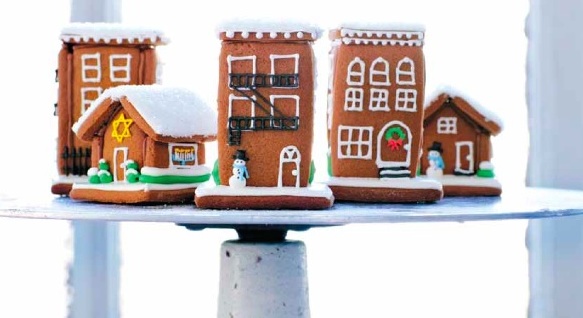
In 1976, a young, redheaded art school graduate named Patti Paige rented a studio in a commercial walk-up in southern SoHo, not far from Canal Street. Her paintings made it into journals and shows, and she also earned money by teaching art, but she soon found work in another medium: cookie dough.
Friends had long raved about Paige’s cookies, so much so that she approached the recently opened Dean & DeLuca, just blocks from her studio. The fledgling gourmet store placed a regular order for her tiny, bite-size walnut pies, made from an old recipe of her grandmother’s. She soon expanded into chocolate chip and peanut butter cookies, and for Christmas 1979 she tapped her sculpture experience and began experimenting with gingerbread houses. These weren’t your typical shrink-wrapped, supermarket fairy-tale fare: Paige rolled out panels of delicious molasses-and-spice- kissed dough, and fashioned the pieces into edible brownstones and cast-iron buildings, which were promptly written up in the Times, the Daily News and New York magazine. Paige began to create a different gingerbread house every season, ranging from mini edible edifices you can hold in your palm, to replicas of buildings including the Sherry-Netherland Hotel, on par in both size and detail with an architect’s presentation model. (Her first large-format production, for example, had 1,800 tiny windows.)
As her sweet successes generated buzz, Paige painted and baked in the same studio. She won a National Endowment for the Arts grant in 1980 and a review the following year in Women Artists News. They praised her work, but cited one flaw: a cookie-cutter-like stiffness. The criticism was doubly ironic because the cookies that Paige creates are anything but routine in their conception; the cutters that she fashions herself from aluminum or copper are themselves original works of art. But beyond the shapes, she treats the cookies as canvases, thinning the icing with water before painting it on, using a process that mimicked the effect of watercolors, and decorating sugar- or chocolate-flavored cookies with abstract and floral images that would not have looked out of place on a museum wall. Soon her cookie customers were commissioning custom designs: icing portraits of children, pets or even other foods. She begins each design as a pencil sketch on paper, then reproduces it on a cookie using simple lines with icing from a sharp-tipped pastry bag before a final application of icing with a paintbrush.
The praise has been effusive. “Dear Ms. Paige,” a more memorable letter read, “You are a genius! I will spend the rest of the year thinking of appropriate words of praise.” “They look like no one else’s Christmas cookies—bright, unconventional and funny, some of the best Christmas cookies around,” raved another magazine piece in her scrapbook, “rescuing gingerbread from cliché—real flavor, real texture and imaginative forms.”
Her treats have since filled the pages of magazines such as O and Martha Stewart Weddings, and even appeared in an exhibit called “The Confectioner’s Art” at the American Craft Museum in Midtown. And this fall, on an episode of Barefoot Contessa, Ina Garten called Paige “the most creative baker I know.”
Most of Paige’s creative energy now goes into pieces to eat rather than works for your walls, but her production space still feels like an art studio, albeit one filled with palettes of hand-mixed icings ranging from the palest pastels to deeply saturated reds and blues and yellows. Also on exhibit are recent works (cookies and cakes layered on cooling racks in various stages of preparation); vintage cake platters and a wall covered with just a fraction of the handmade aluminum and copper cookie cutters she’s shaped over the years.
Though her imagination is actively engaged year-round for wedding cookies, wedding favors, cookies that serve as wedding invitations, monogrammed cookies and even wedding cakes made out of many smaller wedding-cake-shaped pieces, our favorite confections use Manhattan as muse. Starting with those early gingerbread brownstones and apartment buildings,
Paige has long adapted this city to edible form, taking inspiration from politics, news and fashion.
“It began with Dean & DeLuca and Bendel’s and Bloomingdale’s,” says Paige, who added the latter two accounts early on after business at the SoHo shop took off: “They all sell to a lot of tourists who love NYC imagery.”
But native New Yorkers adore her hometown tribute cookies with portraits of Manolo Blahnik high heels, Chinatown fortune cookies and the round buttons that serve as tickets to the Metropolitan Museum of Art. Hillary Clinton herself once placed an order for a fleet of yellow cabs, mini Empire State Buildings and Statues of Liberty for a luncheon.
And each year, in the months and weeks leading up to Christmas, her studio is supercharged. In addition to her regular assistants, Paige hires extra elves to help pipe icing, and sometimes even rents extra studio space to accommodate demand. Designs include Christmas riffs on urban icons: the taxi cookie gets a Christmas tree tied to the roof and the Empire State Building is decked with colored lights.
This holiday season her online site will continue to supply entire cities of gingerbread houses, plus a popular line of cookies and cutters inspired by another city obsession: gingerbread yogis, each charmingly chubby character bent into core-strengthening poses like the warrior, plow and lotus. (A box of 10 yogis is $35; a set of the whimsical cookie cutters is $32.50). It might not be your traditional gingerbread man, but it’s quintessential Patti Paige.



